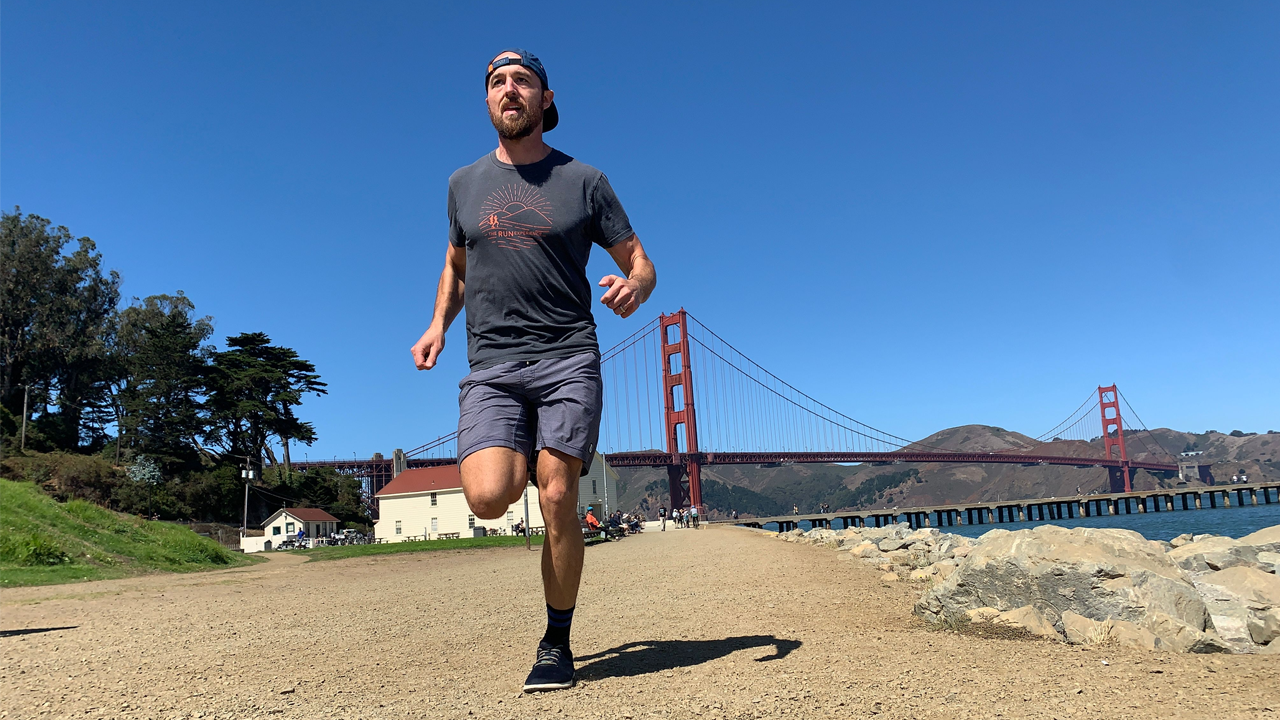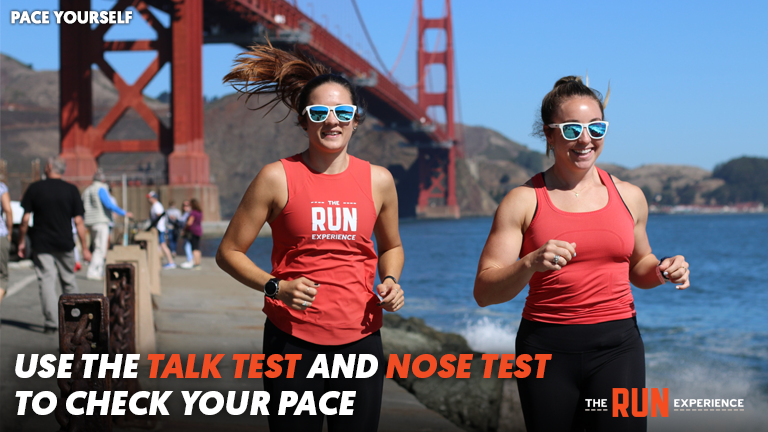How to Pace Yourself When Running (Beginner Running Pace)
Discover how to pace yourself when running. Find your beginner running pace for varying race lengths and never crash early.

Running pace isn’t given—it’s earned. Learning how to pace yourself when running isn’t just for beginners—it’s what set the hobbyists from the pros.
Whether or not we want to admit it, we’ve all been there before. The adrenaline builds. You hear the gun go off. Your legs start moving. Your race pace kicks in too early. Soon, you’re out of gas on the first mile with no finish line in sight.
Learning how to pace yourself is a challenge for many runners. It doesn’t matter if you’re new or experienced—tt takes time to find an optimal running pace without using all your effort levels in the first half-mile.
Want to learn how to pace yourself better and crush your next race (from start to finish)? You’ve come to the right place. Finding the right pace for running different lengths of races is an art—and it’s one we’re here to teach you.
In this article, we’ll show you how you can figure out your goal pace and run at speed that works well for your fitness level.
What Is Running Pace?
Running pace is finding the right sustainable speed to run at. It’s dialing in the right speed to finish your race at the fastest speed without emptying your tank too early.
But that speed isn’t always the same.
Your running pace for a half-marathon is going to be different than your running pace for a 5K. And your pace for running uphill won’t be the same as your pace when going downhill.
There are a lot of variables to consider, and there’s no one-size-fits-all answer. We can’t tell you an ideal pace—we can just give you the tips, best practices, and considerations for you to learn how to pace yourself while running.
Why It’s Important to Pace Yourself
One of the most common tips given to new runners in their training plans is to run at a target pace. Different styles of runs will require different paces, so it’s important for runners to know how much energy they need to exert.
But why is running the right mile pace so important?
Well, pacing yourself helps manage how much energy you have throughout the duration of the run. If you start running too fast during your warm-up, your heart rate will increase, you’ll feel out of breath and you may be unable to finish the race.
However, if you manage the amount of energy you exert at different points throughout the run, you will be able to conserve energy and keep a consistent pace throughout the entire race.
What's a Good Running Pace?
"A good pace for running" is subjective and can vary widely based on several factors, including your fitness level, goals, age, experience, and the conditions in which you're running. Here's a general breakdown of various paces and who they might be suitable for:
1. Walking Pace (20:00 to 15:00 min/mile or 12:25 to 9:20 min/km
Suitable for those who are new to exercise or are using a run/walk approach to build stamina.
2. Easy or Recovery Run Pace (12:00 to 8:00 min/mile or 7:30 to 5:00 min/km)
This is a comfortable pace, allowing for conversational running. It's ideal for beginners or for experienced runners on their recovery days.
3. Moderate or Steady-State Pace (10:00 to 7:00 min/mile or 6:15 to 4:20 min/km)
A pace that is challenging but sustainable over extended distances. It's commonly used for tempo runs or longer workouts.
4. Speedwork or Interval Pace (5:00 to 8:00 min/mile or 3:05 to 5:00 min/km)
Short bursts of speed followed by recovery periods. It's suitable for intermediate and advanced runners looking to improve speed and anaerobic capacity.
5. Elite Pace (5:00 min/mile or 3:05 min/km for men; 5:30 min/mile or 3:25 min/km for women)
This is the pace you'll see elite distance runners maintaining in races.
Why Is It Important to Know Your Pace?
- Training Zones: Different paces correspond to different training intensities and physiological adaptations. For instance, easy runs improve aerobic capacity, while interval runs improve anaerobic capacity.
- Injury Prevention: Overtraining or running too fast without proper build-up can increase injury risk.
- Race Strategy: Knowing your sustainable pace is crucial for race strategy to avoid "hitting the wall" or underperforming.
Remember, a "good" pace is individualized. What's comfortable or challenging for one person might be easy or unattainable for another. It's essential to focus on personal progress and not compare oneself too closely with others. Utilizing tools like pace calculators or working with a coach can help determine the best paces for specific training sessions.
How to Pace Yourself When Running
1. Check Your Rate of Perceived Effort
Running at different paces during your training cycles can help you prepare for maintaining a consistent pace during your runs. The length and style of the run will greatly determine your pace. You might find that you have a 5K pace, 10K pace, marathon pace and more.
However, the way in which you manage them will ultimately come down to how much you’ve practiced assessing and controlling your exertion levels during your runs and strength training.
To understand your run pace, check your rate of perceived effort. The rate of perceived effort takes into account how you’re feeling during the run and what actions you can take at that level of exertion without being completely out of breath.

Let’s take a look at three different types of runs and showcase the ways you can assess your rate of perceived effort and figure out if you’re running at the right pace.
2. Find the Right Pace For Each Run
For each workout and run, runners should make sure they are performing at their optimal pace. But how should you assess your pace without a pace calculator or GPS watch?
We’ll take a look at the best ways to figure out which pace is right for you while you’re completing your long runs, interval runs and tempo runs.
Long Run Pace
If you’re a marathoner reviewing your marathon training plan, chances are there will be many long runs in your future. Long runs are classified as any run that typically takes you more than 45 minutes to complete. They are great training exercises to build stamina, manage your pace and improve your breathing over long periods of exertion.
Long runs should be run at your slowest pace. Runners should exert in between 20-40% of their energy during long runs. This may seem like an easy pace for you for the first few miles, but the goal is to hold that pace for the duration of the run. To understand if you are running your long runs at the right pace, try a talk test or a nose breathing test to gauge your energy levels.
Talk Test Running Pace Assessment
The talk test is a simple, but effective way to assess your long run pace. It is exactly what it sounds like. During your run, find a stride to hold while you are talking. If you start puffing for air while attempting to talk, you’re going too fast. Instead, find a consistent pace that you can hold while chatting with a friend and last to the second half of your long run.
Nose Test Running Pace Assessment
Similar to the talk test, the nose test is an excellent way to assess your pace. (If you’re alone, it’ll look less weird too if you don’t have anyone to talk to during a talk test!) The nose breathing test examines how efficient you are at sustaining your breathing.

During the beginning of your run, try to inhale (and exhale, if possible) only through your nose. If you can manage this, you are running at the right pace. However, if you start to struggle, adjust your pace accordingly by slowing down. Throughout both of these tests, your heart rate may still increase, but you should be able to control it all the way through.
Tempo Run Pace
Tempo runs are your mid-race pace runs, wedged between your long run and interval paces. You should exert in between 40-60% of your energy on these runs. By increasing your pace, you’re able to improve your stamina and prepare for an upcoming race.
To make sure your tempo run pace isn’t too fast, see how many words you can say while running. Don’t worry about saying full sentences like during your long runs. Instead, focus on saying a few words, while staying on top of your breathing.

If you can’t get any words out, you’re going too fast. If you’re talking easily, maybe consider speeding up. This test will help you understand how you’re managing your pace and whether or not you need to speed up or slow down.
Interval Run Pace
Interval runs are the fastest workouts you will likely do during your training. These should be done at the right pace to maximize your fitness gains as well as ensure an injury-free workout.
During your interval runs, you’re typically maxed out on your energy levels—usually at an 80-100% energy capacity. Interval runs are typically your shortest runs, focusing on brief spurts of all-out exertion ranging from 30 seconds to 2 minutes. This type of training is designed to get you to your race pace goal.
The best way to assess your pace during these runs is to ask yourself, “Can I go for that thirty seconds and not have anything left to give?” The goal of interval training is to run your fastest, leaving everything on the table.
While you’re running, think about that question. If you can give more, you’re not running fast enough.
Common Pacing Mistakes and How to Avoid Them
Pacing is crucial for a successful and enjoyable running experience, but even seasoned runners can make mistakes. Here are some common pacing mistakes and tips on how to avoid them to help you feel more prepared and confident on your runs:
Mistake 1: Starting Too Fast
Problem:Many runners get caught up in the excitement at the beginning of a run or race, leading them to start too fast. This can cause burnout and fatigue early on, making it difficult to maintain a steady pace throughout.
Solution:Begin your runs at a comfortable, controlled pace. Use the first mile as a warm-up to ease into your run. Gradually increase your speed as your body adjusts. A GPS watch or running app can help you monitor your pace and prevent you from going out too fast.
Mistake 2: Ignoring Recovery Runs
Problem:Some runners skip recovery runs, thinking they’re not as important as high-intensity workouts. This can lead to overtraining and increase the risk of injury.
Solution:Include recovery runs in your training plan. These runs should be at an easy, conversational pace, allowing your body to recover while still maintaining your fitness level. Listen to your body and take rest days as needed to prevent overtraining.
Mistake 3: Inconsistent Pacing
Problem:Inconsistent pacing, such as speeding up and slowing down frequently, can disrupt your rhythm and lead to inefficient energy use.
Solution:Practice maintaining a steady pace during your training runs. Focus on even splits, where each mile is run at a similar pace. Use pacing tools like a GPS watch or running app to help you stay consistent. Over time, you’ll develop a natural sense of pacing.
Mistake 4: Neglecting to Adjust for Conditions
Problem:Failing to adjust your pace for different weather conditions, terrain, or elevation can result in overexertion and fatigue.
Solution:Be mindful of external factors that can affect your run. In hot weather, slow down to avoid overheating. On hilly terrain, adjust your pace to conserve energy for climbs and descents. Pay attention to your body and adjust your pace accordingly to stay comfortable and safe.
Mistake 5: Relying Solely on Technology
Problem:Over-reliance on GPS watches and running apps can sometimes lead runners to ignore their body’s signals and natural pacing instincts.
Solution:While technology can be a helpful tool, it’s important to develop a feel for your pace without constantly checking your devices. Incorporate some runs where you leave the technology behind and focus on how your body feels. This can help you become more attuned to your natural rhythm and effort levels.
Mistake 6: Skipping Warm-Ups and Cool-Downs
Problem:Jumping straight into a run without a proper warm-up or skipping the cool-down can increase the risk of injury and hinder performance.
Solution:Always start your run with a dynamic warm-up to prepare your muscles and gradually increase your heart rate. Finish with a cool-down that includes light jogging or walking, followed by stretching to aid in recovery and prevent stiffness.
Frequently Asked Questions About Running Pace
What pace should I run at?
Your running pace will vary depending on your goals and workout. If you’re just looking to build your aerobic base and enter the sport (without injury), you’ll want to run at a slow pace that you can maintain. It’s better to run 15 minutes at a consistent pace rather than go out to hard and have to walk after 2-3 minutes.
What is a good beginner running pace?
There is no “good beginner running pace.” It’s all very specific and unique to each runner. A brand-new runner might be pushing themself running a 12:00 pace, while another might find it easy to run a 8:30 pace.
It’ll depend on your genetics, talent, hobbies, lifestyle, diet, sleep, and life stressors. Give your body time to adapt. Your beginner running pace today will likely look very different in a month (and very different in a year). Be patient with yourself.
How to pace yourself consistently?
First, you need a goal to pace yourself consistently. What are you trying to accomplish with your run? Building up your aerobic base is going to look a lot different than trying to win a race or setting a new PR.
You learn how to pace yourself by experimenting and seeing what your body can do. What pace can you hold comfortably for a 5K? When you run your first 10K, do you think you can hold that same pace and push yourself a bit?
These are the kinds of questions you should be asking when learning how to pace yourself. Ask the questions, experiment on your training runs, and adjust your training and goals accordingly.
Practice Makes Perfect Running Pace
Finding the right running pace can be a challenge. However, once you assess your paces during different training runs, these exercises will become a habit.
All runners should mix up the tests performed throughout the week to check their rate of perceived exertion. In addition, runners should routinely check and update their baseline pace for each individual run over time.
You won’t learn how to pace yourself from reading this article alone—you have to lace up your shoes, head to the trail, and start assessing your running pace.
